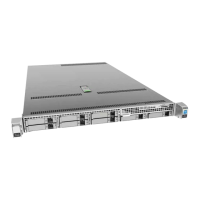2-12
Cisco UCS C220 M4 Server Installation and Service Guide
OL-32473-01
Chapter 2 Installing the Server
Initial Server Setup
Cisco IMC Configuration Utility Setup
The following procedure is performed after you connect to the system and open the Cisco IMC
Configuration Utility.
Step 1 Set NIC mode and NIC redundancy:
a. Set the NIC mode to choose which ports to use to access Cisco IMC for server management (see
Figure 1-3 on page 1-4 for identification of the ports):
• Shared LOM EXT (default)—This is the shared LOM extended mode, the factory-default setting.
With this mode, the Shared LOM and Cisco Card interfaces are both enabled.
In this mode, DHCP replies are returned to both the shared LOM ports and the Cisco card ports. If
the system determines that the Cisco card connection is not getting its IP address from a Cisco UCS
Manager system because the server is in standalone mode, further DHCP requests from the Cisco
card are disabled. Use the Cisco Card NIC mode if you want to connect to Cisco IMC through a
Cisco card in standalone mode.
• Shared LOM—The 1-Gb Ethernet ports are used to access Cisco IMC. You must select a NIC
redundancy and IP setting.
• Dedicated—The dedicated management port is used to access Cisco IMC. You must select a NIC
redundancy and IP setting.
• Cisco Card—The ports on an installed Cisco UCS virtual interface card (VIC) are used to access the
Cisco IMC. You must select a NIC redundancy and IP setting.
See also the required VIC Slot setting below.
• VIC Slot—If you use the Cisco Card NIC mode, you must select this setting to match where your
VIC is installed. The choices are Riser1, Riser2, or Flex-LOM (the mLOM slot).
–
If you select Riser1, slot 1 is used.
–
If you select Riser2, slot 2 is used.
–
If you select Flex-LOM, you must use an mLOM-style VIC in the mLOM slot.
b. Use this utility to change the NIC redundancy to your preference. This server has three possible NIC
redundancy settings:
–
None—The Ethernet ports operate independently and do not fail over if there is a problem. This
setting can be used only with the Dedicated NIC mode.
–
Active-standby—If an active Ethernet port fails, traffic fails over to a standby port.
–
Active-active—All Ethernet ports are utilized simultaneously. The Shared LOM EXT mode can
have only this NIC redundancy setting. Shared LOM and Cisco Card modes can have both
Active-standby and Active-active settings.
Step 2 Choose whether to enable DHCP for dynamic network settings, or to enter static network settings.
Note Before you enable DHCP, you must preconfigure your DHCP server with the range of MAC
addresses for this server. The MAC address is printed on a label on the rear of the server. This
server has a range of six MAC addresses assigned to Cisco IMC. The MAC address printed on
the label is the beginning of the range of six contiguous MAC addresses.

